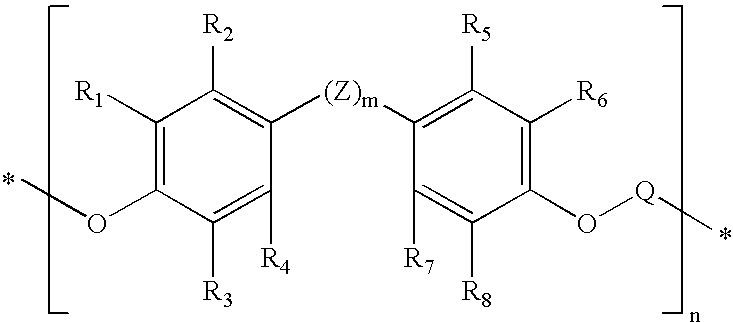Non-xenoestrogenic stabilizers for organic materials
a stabilizer and organic material technology, applied in the field of non-xenoestrogenic stabilizers for organic materials, can solve the problems that plastic and rubber manufacturers are reluctant to utilize tnpp in their formulations
- Summary
- Abstract
- Description
- Claims
- Application Information
AI Technical Summary
Benefits of technology
Problems solved by technology
Method used
Image
Examples
example 1
Synthesis of Octylphosphorodichloridite
Freshly distilled phosphorus trichloride (45.6 g, 0.338 mole) was charged into a four-necked round bottom flask equipped with a mechanical stirrer, an addition funnel, a thermometer, and a reflux condenser itself topped with a discharge tube. The discharge tube led to an aqueous sodium hydroxide trap for absorption of hydrogen chloride that evolves from the reaction. After cooling the reaction vessel to 0° C. with continual purging of dry nitrogen, anhydrous octanol (22 g, 0.168 mole) was added dropwise to the reaction mixture. When the addition of the octanol was complete, the reaction mixture was allowed to warm gradually up to room temperature and was then poured into a dry distillation flask. The material was distilled with a bath temperature of 80-85° C. and using a water pump vacuum to remove residual hydrogen chloride and excess phosphorus trichloride. The residue was then fractionated at 8 mm Hg to yield the product at 113-130° C. in ...
example 2
Synthesis of Bis(2,4-di-t-butylphenyl)octylphosphite (Stabilizer A)
Anhydrous benzene (165 mL), 2,4-di-t-butylphenol (41.2 g) and anhydrous triethylamine (21.0 g, 28.7 mL, 3-4% excess) was charged into a three necked flask, equipped with a mechanical stirrer, reflux condenser and thermometer. After heating the reaction mixture to 35-40° C., 23.1 g of the octylphosphorodichloridite of Example 1 was added. The reaction was heated to 80-85° C. and the reaction mixture was stirred for four hours. The hydrochloride salt of the triethylamine precipitated and was filtered off on a hot funnel and washed with hot benzene. Benzene and excess triethylamine were removed from the filtrate under vacuum. The residue was a mobile, turbid, slightly yellowish product that was again filtered through a hot funnel to remove the small quantity of precipitated salt of triethylamine. The now transparent reaction mass was treated under vacuum at a temperature of 80-85° C. and a pressure of 8-10 mm Hg for 1...
example 3
Synthesis of Poly(4,4′-{2,2′-dimethyl-5,5′-di-t-butylphenylsulfide}octylphosphite) (Stabilizer B)
To a round bottom flask was added 34.6 g (0.1 mol) of diphenyl-(2-ethylhexyl)phosphite, 35.8 g (0.1 mol) of 4,4′-thiobis (3-methyl-6-tert-butylphenol), and a catalytic quantity of metallic sodium (or alcoholate of an alkali metal). The mixture was heated at 180° C. under an atmosphere of nitrogen for one hour. The temperature was reduced to 90-100° C. and the phenol was removed under vacuum (10 mm) over 2.5 hours. When the residual pressure dropped to 1 mm, the reaction mass was subjected to vacuum for two more hours. The residual transparent glassy resin was then ground into a powder. MP=62° C. The yield was quantitative. The phosphorus-31 NMR showed a series of peaks from 126 to 131 ppm.
MWmeas. (cryoscopic in benzene)=1680, n=3, %P 5.63; %S 5.57.
MWcalc.=1642; %P 5.66; %S 5.84
Syntheses of all polyphosphites are carried out by the poly-transesterification reaction of alkyldiphenyl-ph...
PUM
| Property | Measurement | Unit |
|---|---|---|
| weight percent | aaaaa | aaaaa |
| weight percent | aaaaa | aaaaa |
| thermoplastic | aaaaa | aaaaa |
Abstract
Description
Claims
Application Information
 Login to View More
Login to View More - R&D
- Intellectual Property
- Life Sciences
- Materials
- Tech Scout
- Unparalleled Data Quality
- Higher Quality Content
- 60% Fewer Hallucinations
Browse by: Latest US Patents, China's latest patents, Technical Efficacy Thesaurus, Application Domain, Technology Topic, Popular Technical Reports.
© 2025 PatSnap. All rights reserved.Legal|Privacy policy|Modern Slavery Act Transparency Statement|Sitemap|About US| Contact US: help@patsnap.com



